Today Focusrite unveiled the third generation of their Scarlett range of USB audio interfaces.
The new Scarlett interfaces are available in six configurations of ins and outs, paired with high-performing Scarlett mic preamps, along with Air, high headroom instrument inputs, and high-performance converters.
Scarlett 3rd Gen features include:
- Upgraded audio performance: The 3rd Gen mic pre is the best Scarlett has ever experienced. The 24-bit/192kHz converters give users’ recordings clarity, whilst Air mode breathes life into vocals, adding unique high-end detail.
- An interface for everyone: The 3rd Generation of Focusrite’s best-selling interface range includes I/O configurations to suit many situations. Choose from Solo, 2i2, 4i4 8i6, 18i8 or 18i20. The new 4i4 and 8i6 add more line I/O as compared to the 2nd Gen 2i4 and 6i6. New Solo and 2i2 Studio Packs are also available, with Scarlett HP60 MkIII headphone and CM25 MkIII condenser microphone included.
- Breathe life into your recordings: The upgraded mic preamps can reproduce the Air effect of Focusrite’s original ISA mic preamp, giving vocals and acoustic music a brighter and more spacious sound.
- New interactive Quick Start: These interfaces are easy to get up and running, and Focusrite’s Quick Start tool speeds users through registration and guides them through setting up software and drivers.
- Low-latency rock-solid USB driver: USB latency “so low you won’t notice it”: record and monitor everything in real time with many favourite plug-ins in place.
- Type-C USB connection: Utilizing the latest USB connectivity for greater versatility: the Scarlett interfaces plug into a laptop using the supplied USB-C to USB-A cable for use whenever and wherever recording happens.
- Improved inputs and outputs: Instrument inputs with impressive headroom, additional line-level inputs for flexible recording setups, and balanced TRS outputs to eliminate speaker hum.
- Intuitive monitoring features: Focusrite’s “iconic” gain halos light up to indicate input levels, making it easier to create distortion-free recordings.
Every Scarlett interface comes with a range of software tools including:
- Ableton® Live Lite
- Pro Tools® | First Focusrite Creative Pack
- Free three-month Splice Sounds subscription
- XLN Audio Addictive Keys
- Focusrite Red Plug-in Suite
- Softube Time & Tone Bundle
Plus a two-year warranty and membership of the Focusrite Plug-In Collective, offering regular free software downloads and discounts.
Pricing and Availability. The new third-generation Scarlett USB audio interfaces are available now, via authorized dealers or via the Focusrite website, and are priced as follows:
- Scarlett Solo: $109.99
- Scarlett Solo Studio: $219.99
- Scarlett 2i2: $159.99
- Scarlett 2i2 Studio: $269.99
- Scarlett 4i4: $229.99
- Scarlett 8i6: $299.99
- Scarlett 18i8: $399.99
- Scarlett 18i20: $499.99
More information, photographs, and individual product specifications, is available on the Focusrite website.

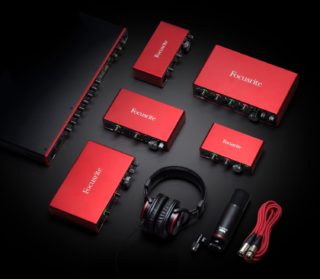

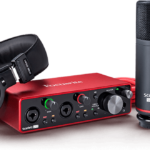

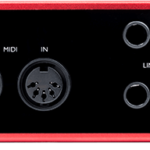
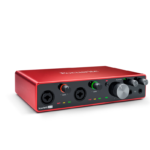


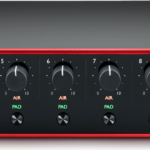




Supports USB-C, but still only passes USB 2.0 presumably? I think one of the new Presonus interfaces also pulled the same trick. Which is a bit disappointing really…
What difference would it make even if it did? USB 2.0 is more than enough bandwidth
USB 2.0 has enough bandwidth to carry more channels than these 18 (And 2 of these are useless SP/DIF)
Not mentioned here but the 1i820 Gen 3 now has now 2 pairs of ADAT, but the manual says: At 44.1/48 kHz sample rate, only the right-hand port of each (ADAT) pair is used . Note that the optical input and output are disabled when sample rates of 176.4/192 kHz are in use.
So they added a pair of ADAT, but not to allow 24 channels of LINE jacks audio !
—————————————————————————————————————–
HUGE opportunity lost . Reason [for me] not to upgrade from my current 18i20. (Gen 1) [Which runs fantastic under Ubuntu together with an OctoPre. Gen 2 support has not been there and Gen3 driver support probably will be unlikely as well)
—————————————————————————————————————
Instead of 3 generations of minor incremental functionality cosmetic changes each within 2 years (adding Air and 192khz sample rates) would rather see Focusrite create a entry level Scarlett without pre-amps and at least 32 line channels or at least a 3 pairs of ADATs in/outs on the 18i20. Lot of folks have more than 16 channels of audio and its nice to have them all hooked up instead of patching.
USB C is a marketing gimmick for Scarlett. It was meant for higher speed, more power, exchange-able connectors, less space needed for the connector and support for multiple device types. No needed for these Scarlett devices, they rather should keep the the robust B type connector. C Instead gave us shorter cables and lots of confusion between what device would work in a C type host connector and actually there are compatibility issues with devices that actually run 3.x
I love these interfaces but I’m very disappointed they changed the mix control from a knob to a button on the 2i4. I used this feature often. I used to do a live performance between a groove box and my DAW and the essential component was a mix control on the interface that let me mix between the inputs and the daw output… The only other interface with this was the m audio fast track pro. This one feature has kept me from upgrading to the 4i4. I might have to try and find a new interface now : (
Still USB 2.0 ? No Way ! They dont care about their customers. Can keep my old audio interface for a while, waiting for a real new thing, not this old one rebranded.
For me USB 2.0 is preferable, it means I don’t have to buy another laptop with Thunderbolt or whatever. If the drivers are as fast as they say, it shouldn’t matter anyways.
Despite what Apple would have you believe, USB 2.0 is still the consumer standard. If a company make an audio interface with just USB C or Thunderbolt then they are selling to a very small market. I’d imagine the last generation of these Focusrites sold more than possibly any other audio interface I can think of. And probably will again. USB 2.0 sells units and offers plenty of bandwidth for most applications
Several of you are confused about USB 2 vs USB C and making it a lot more complicated than you need to.
USB numbers refer to the version of the spec that the device supports. USB 3 has more bandwidth, which you wouldn’t need with these interfaces. USB 2 & 3 devices & computers are compatible – if you connect them, they should work at the speed of the slower device.
USB letters refer to the type of connection on the cable. The big ones you’re used to are USB A, the thin ones on modern computers are USB C. If your device’s cable doesn’t match your computer, you can get a replacement cable that will work for $5-10 on Amazon.
More bandwidth does not matter. But less latency does. USB 3.0 is far better for that.
Focusrite would disagree with you and I’d be inclined to believe them.
https://support.focusrite.com/hc/en-gb/articles/208095469-USB-2-0-vs-USB-3-0
Having said that, this is based on last gen tech
How the full-duplex USB 3.0 could not be better than the half-duplex USB 2.0 ? Focusrite is unable to answer, and sadly, unable to bring to the market a modern product without a lot of latency.
Nearly all mid-range microcontrollers include 1 or 2 USB2.0 ports. Only a handful of devices incorporate USB3.0, and I dont think I can name an affordable mainstream MCU that offers USB3.1.
Music equipment manufacturers are always constrained by available technology; we have this conversation every time that the sales & marketing guys visit our side of the building. They want bluetooth, wifi, dozens of channels and a pony. All for $99. And our answer is always the same, “Yes, when we have a chipset that supports it.”
According to latest information, FR has changed the firmware in this 3rd gen such as way that it is impossible to use under Linux, Great job ! Goodbye for me then. Like, FR, brand state “audio class compliant” but this does not mean USB audio class compliant. Their only they work with the USB class requirements of operating systems (Apple and sometimes MS) which deviate from the USB guidelines. It a marketing trick being used now for so long. Because they are not true compliant, someday they will break at certain OS version and the box can go to the dumpster.. if the interfaces were true class compliant they would work without drivers and with the standard USB class audio drivers OS ship as default. (MS ships a default USB 2,0 driver) Including Linux and Android which for most vendor products is not the case. The vendor driver only should add specific features to make them work with their mixer, tools and whatever add on-features. There should be a USB class compliant certification process, but there is not, so vendor say and do just what they like . But since we all burst from excess money, its does not really matter (to them) products go to waste, right ? This keep customers buyng new stuff So it is not about the consumer but company economics. Common sense.
Just get a Clarett if you dont like the usb connect?
Click on the Focusrite website interface finder, select “PC” and see what options are left… Windows 10 has full TB3 driver support, but the FR products don’t. It is the chip-set vendor that have no appetite to support it.
I love my 18i20 second generation, but after reading a lot about this new series, I can see no reason to upgrade.
Agreed! The latency on the 2nd generation (I have a 6i6) is basically zero for my purposes. Now thinking about picking up another 6i6 2nd gen at discounted price.
The Air effect is a good reason.
I was curious about the Air effect (I suspect a very high frequent high shelf) but I can’t find that function on any of the focusrite ISA models they currently sell (428, 828, one etc.). Does anyone know more? Any old circuit diagrams floating around so one can see what it actually does?
This maybe ? https://focusrite.com/clarett_indepth
scarlett belongs to the past, clarett is ok